What Do Travel Percentages Mean in a Job Description?
Written by Nathan Brunner .
Last updated on December 12, 2023.
“Travel percentages” refer to the amount of time that an employee is required to travel as part of their job responsibilities.
For example, if a job description requires “50% travel,” the employee will be required to spend roughly half of their time traveling and the other half working from their home office or the company’s headquarters.
Before accepting a job that involves travel, it’s important to carefully consider whether you’re willing and able to meet the job’s travel requirements.
Tip : Find Jobs on Salarship .

The Implications of Travel Percentages on Work-Life Balance
Different travel percentages can have significant implications for work-life balance.
For instance, if a job requires very little or no travel, an employee may be able to maintain a more consistent schedule and have more time for personal activities or family commitments.
On the other hand, frequent or extended travel can lead to fatigue, stress, and a lack of personal time, which can negatively affect an employee’s mental health and well-being .
Here is a quick table to help you understand how the different travel percentages will impact your life once you start your job:
- 10% travel — It means one or two months’ worth of business trips each year. In my experience, it is relatively easy to endure as it means a few travel days (or sometimes weeks) here and there.
- 25% travel — You will spend at least a quarter of your working hours away from your usual place of work. It amounts to 3 months per year, one week per month, or two days per week.
- 50% travel — It means constant overnight or international business trips for at least two weeks per month or six months a year. 50% of travel is usually mentioned in international business job descriptions.
- 75% travel — You will essentially live out of your suitcase and move from hotel to hotel for nine months per year, or three weeks each month. Most jobs that require you to travel three-fourths of the time are pretty stressful (e.g., high-paying jobs or jobs in the transportation industry ). You may rake in a hefty salary, but the tradeoff is little time for yourself, your family, and your non-work-related hobbies and goals.
On the bright side, companies usually shoulder most (if not all) of your travel expenses, including food expenses, hotel expenses, and transportation expenses.
How To Get a Job That Requires You To Travel
If you’re deadset on getting a job that includes a travel percentage in the description, here are a few tips to keep in mind — whether you’re writing your cover letter or answering an interview question on whether you’re willing to travel or not.
- Highlight any previous travel experience you have. You want to reassure your potential employer that you’re not likely to, say, suffer from jet lag, or commit novice mistakes like forgetting to apply for a visa in countries that require them.
- Be honest about the amount of time you’re willing to spend traveling. The more honest you are about what you want at the job application or interview stage, the more likely you’ll end up with a job that’s a good fit for you.
Final Thoughts
Evaluating the time you’ll be traveling in a job description can help you decide whether a position is right for you.
On the one hand, traveling often translates to more opportunities for promotion and career growth. On the other hand, traveling can be stressful and take a toll on your physical, mental, and psychological health.
Ultimately, it all boils down to your personal priorities and values.
Similar Articles
- The Meaning of “Clerical Speed And Accuracy” in a Job Description
- What Does “Internal Candidate” Mean When Applying for a Job
Salarship is a job board that focuses on low-competition jobs.
Our office is at Chemin du Valon 20, Sierre, Valais, Switzerland.
For Job Seekers
For Employers
Quick Links
Interview Questions
Comprehensive Interview Guide: 60+ Professions Explored in Detail
How to Answer “Are You Willing to Travel?” (Interview Question)
By Biron Clark
Published: December 5, 2023
If a job involves any travel, you’re likely to hear interview questions like, “Are you willing to travel?” “How much are you willing to travel?” etc.
So in this article, I’m going to walk you through how to answer all of these interview questions. And we’ll look at how to understand the meaning of “travel percentage,” so you’ll know what the job is really going to require before you say “yes” or “no.”
And finally, I’m going to share multiple word-for-word example answers to help you get confident and comfortable with this type of question. So make sure you read until the end.
Let’s get started…
Answers to “How Much Are You Willing to Travel?”
If they ask an open-ended interview question like this about your willingness to travel, you should state your answer as a percentage.
For example, you could say:
“I’m willing to travel up to 30% of the time. That’s what I did in my last job, and I know I’m comfortable with that amount.”
They may ask you directly for a percentage, with a question like, “what percentage are you willing to travel?” and you’d answer that in the same way. What does travel percentage mean, though? If you’re not sure, it’s essential to understand. So let’s discuss the meaning of “travel percentage.”
Travel percentage meaning: What is travel percentage?
So what does 70 percent travel mean? It means that the employer expects you to be traveling or in cities other than your home city for 70 percent of your working days. So you would expect to spend seven days traveling or away from home for every three days in your home town/office.
This is a very high amount of travel. In my experience working as a recruiter , most travel jobs are 50% or below, because this is less stressful and more sustainable for the worker. So, this is something to keep in mind when deciding how much you’re willing to travel, and whether you’ll take or decline the job offer .
How to Answer, “Are You Willing to Travel X Amount?” – Examples
The hiring manager may also come out and tell you how much travel is involved, and then ask an interview question to determine if this is an acceptable travel amount. In this case, if it’s acceptable to you, then you can indicate that you are on-board with what they’re proposing. For example, you could say:
“That amount of travel will work for me. In my last company, I traveled that same amount, and it worked out fine.”
(It’s always good to show you’ve done something successfully in the past. This is the best way to improve to a new employer that you’ll be successful with them, too!)
No worries if you haven’t traveled for a job before, though…
Here’s an example of how you could still answer this question:
“That amount of travel sounds acceptable to me. I have no problem doing that for this role.”
Here’s another example:
“That sounds acceptable to me. I’d love to hear more about the role, and if it’s a good fit, then I am able to travel.”
Make Sure You Know What You’re Agreeing To
Another thing to keep in mind is the actual travel schedule. Two jobs could both have the same travel percentage – let’s say 50%. But one could have you spending two weeks away and then two weeks at home, while the other could have you traveling for 2-3 days at a time, returning, and doing it all again a few days later.
Depending on your family, children, etc., you may be able to handle one of these travel requirements but not the other. So the travel duration and schedule are two factors you should clarify before answering. You can say, “I would like to understand the company travel schedule a bit better. Can you give me an example of how long each trip would be, or what a typical month looks like?” This will help you get a clear picture of what your work schedule would look like before you answer the interview question. So don’t be afraid to ask questions of your own. You can’t answer interview questions like, “Are you willing to travel for this job?” without knowing what the company expects! For example, if they ask, “Can you travel if the job requires it?” you’d want to respond by saying, “How much travel is expected in the role?” You can’t give a good answer without knowing what they’re proposing or asking, so clarify that first. Once you know what the company expects, then it’s time to directly answer their question and indicate whether you can travel the amount they require.
You Can Also Try to Negotiate Your Travel Percentage/Willingness to Travel
If you’re interested in the job but can’t travel quite as much as they’re proposing, you can say:
“I don’t think I can travel quite that amount. The job and work sound interesting, and I’d love to consider the position if the travel requirements can be reduced to 30%”.
This may work, or it may not (depending on the role and company’s flexibility), but it’s worth asking! This way, you’ll find out the best they can do! You never know if they’re asking, “How much are you willing to travel?” because it’s a hard requirement, or if they’re just wondering how much you’re willing to do So give an honest answer and don’t be afraid to make a counter-proposal.
A lot of job seekers are afraid to set limits or “push back” in a job interview, but this can actually make you more attractive to the company. It shows confidence! However, you also don’t want to rule yourself out in an interview. So if you’re not quite sure, but think it’s possible to travel the amount that the company would like, just say “yes” for now. You’re not accepting the job or signing a contract. You’re just indicating whether this might be possible for you. And your goal in any interview is to get invited to the next step in the process… or get a job offer. So if you think it’s even remotely possible to travel the amount they want, then yes “Yes” and keep interviewing!
You can always go home and talk to friends and family and make a better decision about whether this is right for you! You do NOT need to decide this in the interview!
How to Answer, “Are You Willing to Travel or Relocate?” – Examples
This is a slightly different question. But just like with the questions and sample answers above, you should give an honest, upfront answer. There’s no sense in wasting their time if you absolutely cannot relocate. But if it’s even slightly possible, say “Yes” when an employer asks if you’re willing to relocate. Don’t rule yourself out.
Remember: Your goal in the interview is to impress them and get invited back to the next round – so keep going with the job interview, and ask questions to learn more as you go! You’re NOT wasting the recruiter’s or hiring manager’s time by exploring the opportunity, as long as there’s a tiny chance you’d be willing to travel or relocate for the job. They want the opportunity to sell you on their position! I can’t stress this enough: You’re not wasting their time. I hear a lot of job seekers bring up concerns about this, so I just wanted to set the record straight!
You should now know what travel percentage is, and how to answer any time an employer asks about what percentage you’re willing to travel.
Remember – you’re not signing a contract or agreeing to anything in writing; you’re merely indicating whether this could potentially work (for the right opportunity). So stay calm, use the sample answers above, and be direct/concise when responding in a job interview.
This isn’t one of those interview questions where the hiring manager needs to hear a long-winded answer. So once you’ve answered the question, stop and let the interviewer move on!

About the Author
Read more articles by Biron Clark
Continue Reading
12 Expert-Approved Responses to ‘What Makes You Unique?’ in Job Interviews
15 most common pharmacist interview questions and answers, 15 most common paralegal interview questions and answers, top 30+ funny interview questions and answers, 60 hardest interview questions and answers, 100+ best ice breaker questions to ask candidates, top 20 situational interview questions (& sample answers), 15 most common physical therapist interview questions and answers.
talentboard.me
- Skip to primary navigation
- Skip to main content
- Skip to primary sidebar
- Skip to footer
Career Sherpa
Guide for Lifetime Career Navigation
- Search this site...
Answering “What Percentage Are You Willing To Travel?”
September 14, 2023 by Hannah Morgan
Talking about what percentage of time you’re willing to travel for work is something that trips up a lot of applicants. They often say what they think an interviewer wants to hear instead of an honest and well-prepared answer.

This guide will help you understand what interviewers are looking for when they ask this question, and how you can develop a response that works for everyone.
Table of contents
What does travel percentage mean, how to answer “are you willing to travel”, example answers.
- placeholder
When a position requires travel, employers typically discuss how much time you’d have to spend in cities other than your own in terms of percentages. For example, a company may advertise a position as requiring “50 percent travel.”
In that case, it means that the employer wants the person hired for that position to spend half of their working days traveling. For every ten days of work, you’d spend five traveling between cities or working in an area outside your home city.
Most travel jobs have a percentage of 50 percent or lower. But you can easily find positions that require more. For example, some engineering, training. and sales jobs have workers traveling 70 percent of the time! Some companies even offer positions that require 100 percent travel time.
It all depends on the industry and the unique position you’re applying for.
Understanding what a company means by “travel percentage” is important to grasp what an employer wants from a new hire. Travel jobs can be fun, but they’re also demanding. You’ll need to spend time away from your family and friends, and the lifestyle is much different than a standard nine-to-five.
While not always the case, many travel percentage requirements are negotiable. A question like this opens the door to that, giving hiring managers a better idea of what you can realistically do if hired.
Many job seekers fear answering a question like this because they believe that interviewers have something specific they want to hear. However, you can still be honest and set limits without hurting your chances of getting further into the hiring process.
Here are some tips on how to answer this question the right way.
1. Decide What You Want Ahead of Time
The most important thing you need to do is decide how much you’re willing to travel before you head into the interview. Nothing will ruin your chances faster than interviewing for a position that requires traveling, and saying you can’t travel at all (or aren’t sure how much you’re willing to travel). You likely won’t be in the running at all if that’s the case.
Do your research and read the job description closely. Employers are usually upfront about travel expectations. Travel percentages can be negotiable, but do note if the job posting mentions travel, some travel will be required.
Know what you want before you head into the interview. Think about how much travel you can do and how that might affect your life moving forward. Then, have a general travel percentage in mind.
Deciding how much you’re willing to travel will give you everything you need to answer this question confidently.
Interviewers don’t want wishy-washy answers or the dreaded “I don’t know.” If you want to sound confident and serious about this position, know what you want before your meeting.
It’s also important to look into how travel is structured for each position. While companies discuss travel time in percentages, that doesn’t necessarily mean you’ll spend X amount of days on the road and X amount of days in an office in your home city.
Some positions require you to travel several weeks at a time before spending a few weeks off at home. Those trips could be regular or sporadic based on the company’s needs.
Understand what you’re getting into and what the job requires. Do your research to avoid any surprises!
2. Be Honest & Clear
Contrary to popular belief, you don’t need to say that you’ll do whatever the company wants in order to get a job.
Travel is a big commitment. Employers and hiring managers know that. They understand that considerable travel is not for everyone, so they appreciate the honesty.
Be clear about whether you’re willing to travel most of the time or can only be on the road a few days out of the month. Be honest and set your boundaries.
The last thing any hiring manager wants to hear is a vague answer. Your response is important because it directly impacts your fit for the job. For example, some companies might have hard travel requirements that are non-negotiable. In those cases, they need a firm confirmation that you can or cannot meet their required travel percentage. Otherwise, you’d waste their time and yours moving forward. That’s why you should consider what you want from your job before the interview.
Be honest and clear. Don’t lie because you think it might increase your chances of getting a job. While lying might help you move further into the hiring process, it won’t do any good when you can’t hit the road once hired.
The best scenario is already knowing what travel percentage you can work. Discuss those limits during your interview. But you can also express interest in negotiations.
You can tell the interviewer you’re willing to travel but want to learn more about the other job expectations. While not as ideal as providing a percentage, that’s usually enough for interviewers to proceed. Interviews aren’t job offers, and you’re not signing contracts at that point.
So, there’s still room for further discussion. The most important thing is that you’re upfront and have some idea of what you can do going into the interview.
3. Show That You Understand How Travel Relates to the Job
Another important thing to do when answering this question is to demonstrate that you understand the job.
Travel jobs are appealing to many people. One concern that many hiring managers have is that applicants try to get the job because they simply think it’s a cool way to see new places. While that can be true for some jobs, you’re not getting hired to explore new cities and go on vacation!
It’s still a job, and you’ll have important responsibilities.
Show that you understand the job and are there for the right reasons. One way to do that is by talking about some of the unique responsibilities of the job or demonstrating that you know how important travel is for this position.
For example, you can connect the reason why this job requires travel to your work. If the job revolves around sales, you can mention that you understand that traveling is crucial to gaining more clients across the state. If it’s a consulting job, you can discuss how traveling to companies allows you to better assess the situation and build better connections inside companies.
This seemingly small detail makes a difference. It shows that you’re seeking this job for the right reasons and are committed to doing a fantastic job.
4. Highlight the Positives
Finally, highlight some of the positive aspects of travel. That doesn’t mean you should lean too heavily on wanting to get out and explore. Remember: You still have a job and must demonstrate your commitment to doing it.
However, mentioning some of the things you love about jobs that require frequent travel can reassure hiring managers that you’re up for the challenge. An example of this could be networking and meeting new people in a professional setting.
Travel jobs can be overwhelming for some people. It can lead to burnout, and many employers struggle with low retention rates for these positions.
The ultimate goal for hiring managers is to find someone who thrives in a job that requires traveling. The best people are those who love getting on the road and don’t mind some of the common pitfalls of being in a new place and spending time away from friends and family.
If you show this job will be a positive experience, hiring managers may put your application at the top of the stack.
Connect your past experiences to what you hope to gain from this new job. For example, you can refer to how great previous travel jobs were for you. If you don’t have any related work experience, you can mention times when you studied abroad or spent significant time on the road.
Focus on your love of new experiences and highlight all the great things you’ll gain from this job.
There are many ways to answer “Are you willing to travel?” and how you respond depends on your needs. But these examples will give you a good idea of the type of answers that interviewers love to hear.
In the first example, we have a candidate with some experience traveling in a previous job. They leverage that work experience to reassure the interviewer that they can handle the responsibilities.
“I am willing to travel for work. I traveled about 40 percent of the time in my last job. I’m prepared to do the same here because I know I’m comfortable with that amount of time on the road. I’ve learned how to manage and succeed despite the time away from home. In my last job, I’d spend weeks traveling to cities across the eastern seaboard. I got to work with great people in cities I enjoyed plus I found time to explore many beautiful states. I’m excited at the chance to do the same here while working to fulfill your company’s objectives.”
Our next example is straightforward. The candidate demonstrates that they understand the company’s expectations and use their previous experience to reassure the interviewer that they’re up for the task.
“I’m definitely willing to travel. In my last sales job, I spent about half my time on the road while traveling to cities around the state. It was a great experience, and I had no trouble getting comfortable doing it. The roughly 30 percent travel percentage mentioned in the job posting sounds more than acceptable to me. I have questions about the frequency and the average length of business trips, but I’m certainly willing to spend time traveling.”
Our final example comes from a candidate who has no travel experience. However, they go into the interview knowing what they want and provide a confident answer, demonstrating their understanding and willingness to work hard.
“I’m more than willing to travel; I’m looking forward to it. Not only do I enjoy working with new people, I also like the excitement of traveling to new places. Your job posting mentioned that the position will require at least 50 percent travel time. I can travel as much as 75 percent if the job requires that. I know that your company has offices across the western United States. As a trainer, I understand that visiting those offices and working with people directly makes a big difference in their success. I’m eager to get my hands dirty and do what I can to help others while improving the collective expertise of this company’s employees.”
As you can see, spending some time thinking about the percentage of time you’re willing to travel is just part of the equation. You also need to be honest with the interviewer about what works for you!
If you practice your answer and follow these rules, this question won’t cause you any trouble.

Hannah Morgan speaks and writes about job search and career strategies. She founded CareerSherpa.net to educate professionals on how to maneuver through today’s job search process. Hannah was nominated as a LinkedIn Top Voice in Job Search and Careers and is a regular contributor to US News & World Report. She has been quoted by media outlets, including Forbes, USA Today, Money Magazine, Huffington Post, as well as many other publications. She is also author of The Infographic Resume and co-author of Social Networking for Business Success .

- Interviewing
- Career Management
- Social Media
- Summary Sunday
- Products & Services
NEVER MISS A POST!
Don’t miss out on the latest tips and tricks for a successful job search! By subscribing, you’ll get a weekly digest of modern job hunting trends. Whether you’re just starting your career or looking to take it to the next level, my newsletter has everything you need to succeed. Join the community today and stay ahead of the game!
SIGN UP HERE!
- More Networks
Explore Jobs
- Jobs Near Me
- Remote Jobs
- Full Time Jobs
- Part Time Jobs
- Entry Level Jobs
- Work From Home Jobs
Find Specific Jobs
- $15 Per Hour Jobs
- $20 Per Hour Jobs
- Hiring Immediately Jobs
- High School Jobs
- H1b Visa Jobs
Explore Careers
- Business And Financial
- Architecture And Engineering
- Computer And Mathematical
Explore Professions
- What They Do
- Certifications
- Demographics
Best Companies
- Health Care
- Fortune 500
Explore Companies
- CEO And Executies
- Resume Builder
- Career Advice
- Explore Majors
- Questions And Answers
- Interview Questions
How To Answer “Are You Willing to Travel?” Interview Question (With Examples)
- How To Answer Tell Me About Yourself?
- Elevator Pitch
- Where Do You See Yourself In 5 Years?
- What Are Your Career Goals?
- When Can You Start?
- How Do You Define Success?
- Describe Your Work Ethic
- Where Are Your Current Duties?
- What Are Your Learning Goals?
- Intrinsic Vs Extrinsic Motivation
- What Is Your Desired Salary?
- What Makes You Unique?
- Why Are You The Best Person For This Job?
- Reasons For Termination
- What Are Your Work Values
- How To Make A Hard Decision?
- What Are You Most Proud Of?
- Personal Code Of Ethics
- Problem Solving Interview Questions
- Taking Initiative Example
- How Do You Prioritize Your Work
- Explain Gaps In Employment
- Most Rewarding College Experience
- What Is Your Work Style
- Tell Me About A Time When You Made A Mistake On The Job
- Tell Me About Gaps In Employment
- What Are You Passionate About
- What Skills Would You Bring To The Job
- Who Is Your Mentor?
- How To Answer Tell Me About A Time You Disagreed With Your Boss
- How To Answer Common Screening Questions
- How Do You Handle Stress
- Are You Willing To Travel?
- Situational Interview Questions
- Promotion Interview Questions
- Internal Interview Questions
- Open Ended Interview Questions
- Tough Interview Questions
- Leadership Interview Questions
- Teamwork Interview Questions
- Interview Questions About Communication
- Personality Interview Questions
- Internship Interview Questions
- Ice Breaker Questions
- Recruiter Interview Questions
- Brain Teaser Interview Questions
- Group Interview Questions
- Competency Based Interview Question
- Grad School Interview Questions
- Scrum Interview Questions
- Excel Interview Questions
- Common Phone Interview Questions And Answers
- Why Did You Choose Nursing?
- Why Do You Want To Be A Teacher?
- Why Do You Want To Be A Doctor?
- Why Do You Want To Be A Police Officer?
- Police Officer Interview Questions
- Why Do You Want To Be An Accountant?
- Sales Interview Questions
- Interview Questions For Managers
- Retail Interview Questions
- Teacher Interview Questions
- Accounting Interview Questions
- Teaching Philosophy Examples
- Management Philosophy Examples
- Leadership Philosophy
- What Does Customer Service Mean To You
Find a Job You Really Want In
Summary. To answer, “Are you willing to travel?” in an interview, give an example that demonstrates your willingness to travel and communicate any boundaries or limitations you may have. You should also clarify what the travel expectations would be before accepting the job. When getting asked if you’re willing to travel for your job, the instinctive response would be to say yes. After all, who wouldn’t want the opportunity to explore a new place on your company’s dime? Here are a few things to consider before accepting a traveling position: Key Takeaways: When answering this question it is important to talk about positive travel experiences, demonstrate a thorough understanding of the job, and talk about networking. You should avoid lying about your availability, any negative travel experiences, and go overboard when talking about the good experiences. Before taking the job, it is important to clarify travel percentages, any expenses you may have, and what type of travel it is. In This Article Skip to section How to Answer “Are You Willing to Travel?”: Dos and Don’ts Example Answers to “Are You Willing to Travel?” What You Should Ask About Travel During Your Interview What Does “Willingness to Travel” Really Mean? Are You Willing to Travel FAQ Final Thoughts References Sign Up For More Advice and Jobs Show More How to Answer “Are You Willing to Travel?”: Dos and Don’ts
When it comes to actually answering the question when it’s posed to you by a hiring manager, there are a few things you ought to bring up — and some things you should just avoid entirely .
The DO’s:
Talk about positive travel experiences. They’re looking for someone who is comfortable with spending a lot of time away from friends, family, and the home office — you want to do as much as you can to assure them that traveling is something you find invigorating and fun.
So go ahead and bring up that study abroad trip, even if it’s a little out of date.
Demonstrate a thorough understanding of the job. Whatever it is you’re doing, your company won’t just be sending you places so you can eat cool food in new places.
They want you to work, and understanding that you’ll be working regardless of whether you’re traveling is important to be considered for the job.
Bring up the unique job responsibilities of the position as you understand it and explain your commitment to fulfilling them.
Talk about networking . A lot of work in a traveling position requires talking to other human beings and making business connections that stick.
For this reason, it’s important to show hiring managers that you know how to make these kinds of connections by talking about networking experiences you’ve had in the past — and it wouldn’t hurt to engage in a little small talk during the interview itself, either.
The DONT’s:
Lie about your availability. If you can’t travel at all, don’t apply in the first place, but your employer needs to have a realistic understanding of your ability to travel if they’re going to hire you for the position .
So if you can’t do weekends or certain percentages of the week, let the hiring manager know up front.
Focus too heavily on your availability either. Giving a specific maximum amount of travel you’re able to do can look bad as well, especially if that maximum is below the company’s expectations. So tell them your availability, but don’t spend too much time on it.
Bring up negative travel experiences: These are fine to talk about once you have the job, but during the interview process it will just make you look like you associate these experiences with traveling and that you are even perhaps lying about how comfortable you are with traveling.
Go overboard talking about good experiences: As bad as it is to talk about bad experiences, it can be just as damaging if the only good experiences you talk about are vacations or day trips.
After all, they expect you to work while you’re on these trips, so if they think you associate traveling just with vacations and relaxing, they might not have the most faith in your dedication to work.
Example Answers to “Are You Willing to Travel?”
Yes, I’m absolutely willing to travel. I spent a year studying abroad before graduating last year, and I learned that I love experiencing new places and meeting new people regularly. During my internship at The Coastal Society, I regularly traveled to different coastal sites to meet with marine biologists and gather data. I really enjoyed that aspect of the job, so I’m definitely open to making travel a bigger part of my professional life.
I am certainly willing to travel for work. At my last job in sales, I spent about half my time on the road, so the roughly 25% travel time we discussed for this job sounds more than acceptable. I just have a few more questions about how frequently trips are taken for this position and the typical length of a business trip.
While I’m willing to travel (and love traveling), my spouse works on the weekends and we have three kids at home. As such, I need to keep my weekends free for childcare. But any travel during the workweek I can happily accommodate.
What You Should Ask About Travel During Your Interview
The reasons why the company needs you to travel can vary wildly, and as a result, the particular travel experiences you’ll have could vary even for two similar positions.
It’s important for this reason to figure out exactly what sort of travel the company expects you to undertake before you get too far into the interview process .
A few things you should clarify before you take the job:
Travel percentage. If a job is advertised as having a travel percentage of 20%, that doesn’t necessarily mean that you’re traveling every Friday, or alternatively that you’re only traveling one week of every month.
That 20% is an average , and what it represents can vary dramatically by career, so make sure you ask your hiring manager to tell you exactly what the travel percentage means for the position you’re applying for.
Expenses. Namely, are they paid? How much of your food is being covered? Gas? Other travel expenses?
It’s important to know this beforehand — while many places will reimburse you for every expense you incur while on the road, it’s important to know what the company’s official policy is for travel.
Type of travel. Will it mostly be flying? Will you be expected to drive to the locations you’re going to? Where will you usually be traveling to?
Where would the company prefer that you stay while you’re there? Will you be staying anywhere at all, or are the trips too short for this?
What Does “Willingness to Travel” Really Mean?
There are two major kinds of travel jobs :
Seasonal jobs. These exist only for a few months or even just a few weeks and may require you to travel for the entirety of the time you’re working the gig.
“Regular” job that require travel. For these kinds of jobs, the amount of traveling that occurs can vary dramatically depending on the position.
Here are a few things that might be expected of you if you enter a job like this, seasonal or not, and some things you should keep in mind before giving your final answer.
You might have to make day trips, but the company may not be willing to pay for you to stay overnight. This could mean long work days punctuated by large amounts of travel which could keep you awake for 16 hours or more.
Alternatively, you might be sent very far away and be expected to fend for yourself once you get there. You may not have much, if any, time to explore this place between takeoffs — you might just be working the entire time.
Relocation should NOT be expected of you unless it’s discussed at this time as well. It’s also important to note that there is a big difference between being willing to travel and being willing to relocate.
Are You Willing to Travel FAQ
What does it mean when a job asks if you’re willing to travel?
When a job asks if you’re willing to travel, it usually means there is at least some travel required for the position. The exact amount will vary, but there will typically be enough for interviewers to find out how well your willingness to travel aligns with the job’s requirements.
How do you put willing to travel on your resume?
You can put willing to travel on your resume by noting how much you traveled at your last position. This will point out to recruiters that you’ve at least been willing to travel in the past and may be willing to again.
If you haven’t had a position that requires travel before, you can note your willingness to travel in your resume summary . This is usually only a best practice if you’re aplying for a job or are in an industry that typically requires travel. Otherwise, it could look out of place and come off as ignorant.
Final Thoughts
Traveling is often one of the most exciting parts of any job that includes it and, despite the huge amount of work that gets compressed during these trips, it can be very fun if you’re adequately prepared for it.
When it comes to working travel jobs, you really have to be ready to go all in. That’s why it’s so important to understand what a company is asking when they want to know if you can travel.
Not only will it make you look proactive and interested in the position, but it can help keep you from getting in over your head with a situation you’re not comfortable with or ready to undertake.
And whatever you do while you’re out exploring the world, make sure you don’t stray too far from the hiking trail. That’s how you get bear maulings, and those usually aren’t covered under company expenses.
Anyhow, best of luck to you! Here are some other links to help you on your way.
- 3 Tips For Successfully Calling In Sick (Even If You’re Not)
- 13 Job Search Mistakes You Might Not Even Realize You’re Making
- 3 Steps To Reject A Job Offer Without Burning Bridges
Illinois Graduate College – Sample Interview Questions
How useful was this post?
Click on a star to rate it!
Average rating / 5. Vote count:
No votes so far! Be the first to rate this post.

Ryan Morris was a writer for the Zippia Advice blog who tried to make the job process a little more entertaining for all those involved. He obtained his BA and Masters from Appalachian State University.

Related posts

How To Answer The Interview Question “What Are Your Career Goals?” (With Examples)
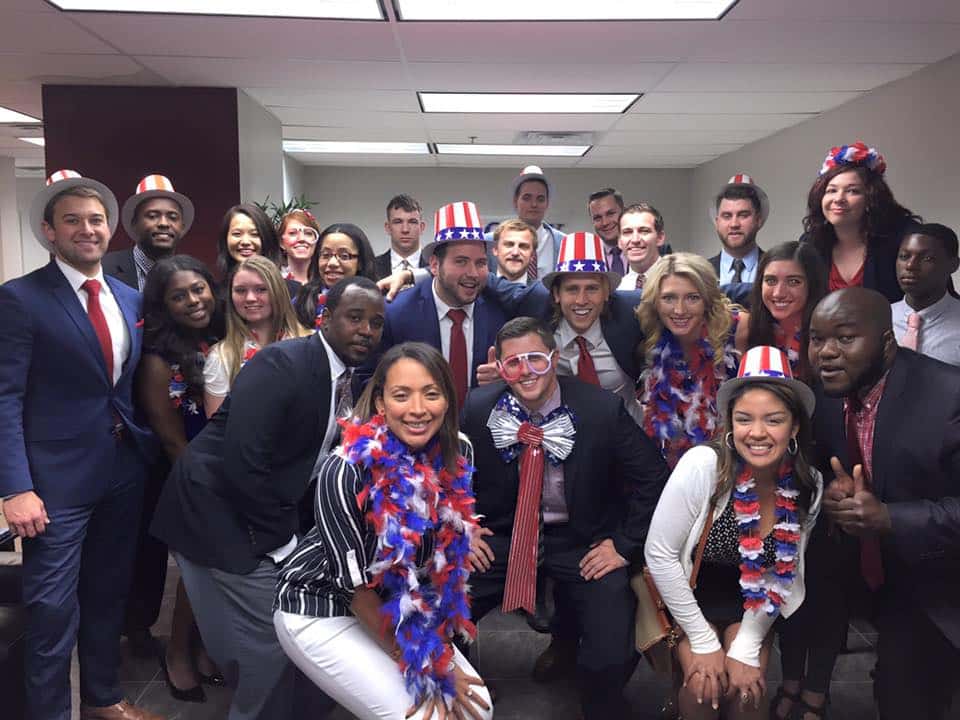
How 27 People Got Jobs Unrelated To Their College Majors

How To Answer “Who Is Your Mentor?” (With Examples)
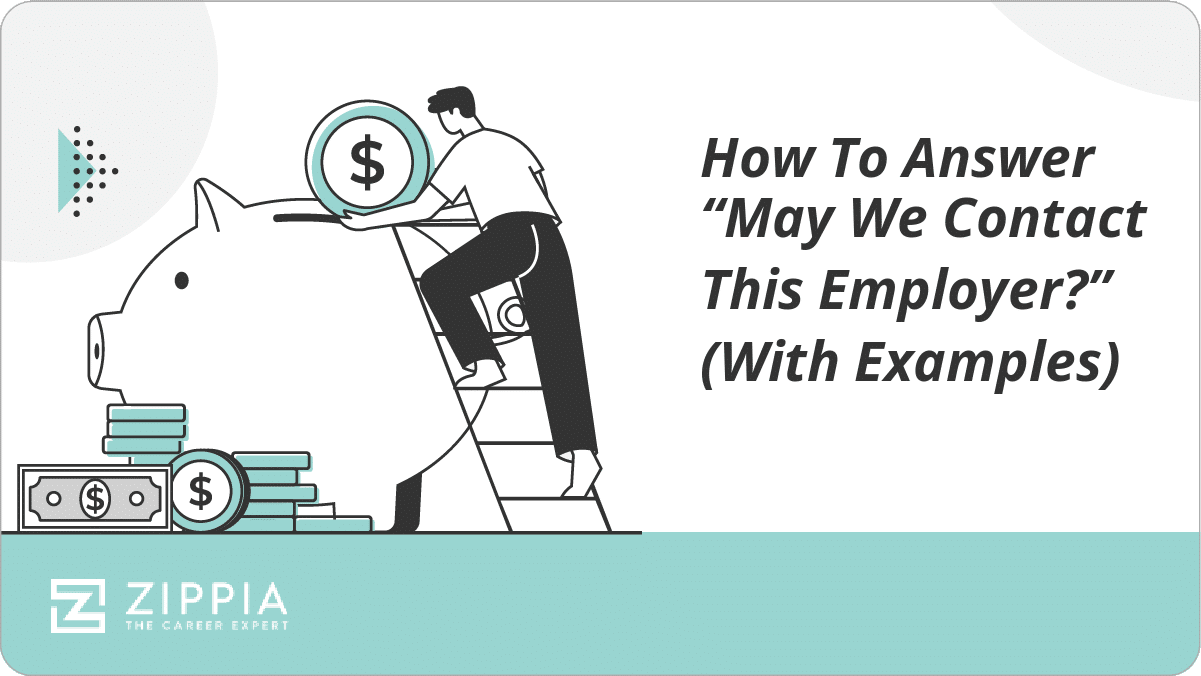
How To Answer “May We Contact This Employer?” (With Examples)
- Career Advice >
- Get The Job >
- 3 Tips Are You Willing To Travel
- Job Search Advice
- Interviewing
- Login/Register
- Tough Interview Questions
- Tough Interview Question: Are you willing to travel? How much?
Tough Interview Question - Are you willing to travel? How much?
Are you willing to travel? How much?
Similar interview questions: Do you own your own car? Are you willing to use it for business travel? How many nights per week are you willing to be on the road? Is there anywhere in the world where you would not be willing to travel? How much travel have you done in your life? Do you enjoy it?
Why the interviewer is asking this question: Some jobs involve an element of travel. It could be travel to different work locations or it could be travel as part of the job itself, such as travel to different client locations. The interviewer wants to know if you are open to travel and whether you are travel-preferent (some people enjoy the travel component of their work) or travel-tolerant (not necessarily enjoying the travel, but understanding it is a part of the job).
The best approach to answering this question: If you are open to travel, say so and say how much, usually noted as a percentage. Travel can sometimes be difficult to quantify as a percentage, since it usually refers to overnight travel, with each 20% indicating one night of travel per week. So travel done during the day, but returning that evening is technically not counted as business travel, although the travel itself usually is covered as a business expense. Also, 20% travel could mean overnight travel once a week or a full week out of town every 5 weeks or a full month out of town every 5 months. So it’s important to ask for specific examples of what the travel will look like if you are agreeing up front to travel requirements for the role.
An example of how to best answer this question for experienced candidates: "I do have flexibility to travel and have done so in my most recent role, which requires approximately 20% travel. How much travel is required for this role and what are some examples of the travel that would be involved?"
An example of how to best answer this question for entry level candidates: "I have no limitations on my ability to travel for my work and I have done extensive travel to date, including my semester abroad last year. Can you tell me more about the type and scope of travel which may be involved for this role?"
An example of how you should not answer this question: "Well only if I’ve got a big fat expense account to draw from when I travel. Then I don’t mind, since I can pad in all the extra expenses that would make it worthwhile. Would I get to fly first class?"
Further review: know the answers to these Standard Interview Questions to be fully prepared for your interview!
Search for jobs:

An official website of the United States government
Here's how you know
Official websites use .gov A .gov website belongs to an official government organization in the United States.
Secure .gov websites use HTTPS A lock ( Lock Locked padlock ) or https:// means you've safely connected to the .gov website. Share sensitive information only on official, secure websites.
How to filter results by travel percentage
You can filter your search results by the amount of travel the job requires. Read the Travel Required section in each job announcement to understand the travel requirements.
- Go to More Filters .
- Scroll down to Travel Percentage .
- Select the amount of travel you're looking for – you can select more than one.
Your search results will update automatically as you select each filter.
Types of travel
Not required.
The job does not require any travel.
Occasional travel
The job may require travel from time- to-time, but not on a regular basis. The travel may be for training or other work-related duties.
25% or less
The job may require up to 25% travel.
50% or less
The job may require up to 50% travel.

75% or less
The job may require up to 75% travel.
76% or greater
The job may require 76% or more travel.
Still need help?
What does up to 10% travel mean?
Faqs about up to 10% travel, 1. do i have to travel every week if my job requires up to 10% travel, 2. how is the travel percentage calculated, 3. is travel time considered working hours, 4. will the company cover my travel expenses, 5. can i choose when and where to travel, 6. is the 10% travel requirement negotiable, 7. how does travel impact work-life balance, 8. what should i do if i have travel-related concerns, 9. are there any health and safety considerations regarding travel, 10. how can i make the most of my travel opportunities, 11. is international travel included in the “up to 10% travel” requirement, 12. can travel percentage change over time, what does up to 10% travel mean.
When you come across the phrase “up to 10% travel,” it refers to the maximum amount of travel required for a particular job or role. This percentage indicates that you may be expected to travel for work-related purposes up to 10% of your working hours or time. It implies that travel is not a constant requirement, but rather an occasional aspect of the job.
In practical terms, this means that if you work full-time, which is typically 40 hours per week, you can anticipate spending up to 4 hours per week on travel-related activities. This could include commuting to meet clients, attending conferences or meetings in different locations, or visiting other company branches or sites. However, it’s essential to remember that the actual travel time may vary from week to week, and it may not always amount to the full 10% of your work schedule.
When a job description mentions “up to 10% travel,” it doesn’t necessarily mean you will travel every week. The travel expectation may vary depending on projects, meetings, or other business needs. Some weeks may involve no travel at all, while others may require more. The goal is to maintain a balance between work conducted at a fixed location and work that involves traveling.
The travel percentage is usually calculated based on the total number of working hours. If you work 40 hours per week, 10% travel would equate to 4 hours spent on travel-related activities. This could include time spent journeying to client meetings, attending conferences, or visiting other company sites.
Typically, travel time is considered part of your working hours if it occurs during your designated work schedule. However, this may vary depending on the company’s policies and your employment agreement. It’s advisable to clarify this with your employer to ensure mutual understanding.
Travel expenses are usually determined by the company’s travel policy. Some employers may provide reimbursements for transportation, accommodation, and meals, while others may use a per diem system to cover expenses during business travel. Check with your employer to understand their travel expense guidelines.
The possibility of choosing when and where to travel within the “up to 10% travel” framework depends on the nature of your job and the company’s requirements. In some cases, you may have the flexibility to schedule your trips, while in others, travel plans may be determined by project needs or client demands. Discuss travel arrangements with your supervisor to get a clear picture of the expectations.
In certain instances, employers may be open to negotiating the travel percentage based on your specific circumstances or preferences. However, keep in mind that the flexibility may vary from one organization to another. It’s best to have open and honest communication with your employer during the negotiation process.
The impact of travel on work-life balance depends on individual factors such as personal commitments, preferences, and adaptability. While some individuals enjoy the opportunity to explore new places, others may find it challenging to maintain a balance between professional and personal life during travel. It’s essential to evaluate your priorities and consider how travel aligns with your lifestyle.
If you have concerns about travel requirements or any related issues, it’s advisable to discuss them openly with your supervisor or human resources department. They can provide guidance, address queries, and work towards finding suitable solutions that accommodate both your needs and the company’s objectives.
When traveling for work, it’s crucial to prioritize health and safety. Familiarize yourself with the company’s travel policy, including guidelines for emergency situations, travel insurance, and health precautions specific to the destinations you may visit. Stay informed, follow safety protocols, and take necessary precautions to minimize risks while on the road.
To make the most of your travel opportunities, embrace them as learning experiences. Explore different cities, engage with local culture, and network with professionals in your field during conferences or industry events. Take advantage of the chance to broaden your horizons, gain new perspectives, and build meaningful connections.
The scope of travel, including whether international travel is included in the “up to 10% travel” requirement, is specific to the job description and company policy. Some roles may involve domestic travel only, while others may also require international trips. It’s crucial to refer to the job description and discuss any uncertainties with your employer.
Yes, the travel percentage can change over time depending on various factors such as organizational needs, project requirements, or your career progression. As you grow professionally, your responsibilities may evolve, potentially impacting the travel component of your role. Stay in communication with your employer to stay informed about any changes that may occur.
Remember, the “up to 10% travel” indication in a job description provides an estimated expectation rather than a rigid requirement. It offers flexibility for employers and employees to strike a balance in incorporating travel into work assignments.
About The Author
Isabel MacKintosh
Leave a comment cancel reply.
Your email address will not be published. Required fields are marked *
Save my name, email, and website in this browser for the next time I comment.

- Brand Resources
- Economic Impact
- WTTC Research Hub
- Insights & Publications
- Knowledge Partners
- Data Enquiries
- Sustainability Hub
- Hotel Sustainability Basics
- Nature Positive Travel & Tourism
- Social Impact
- Community Conscious Travel
- Security & Travel Facilitation
- Women Empowerment
- Destination Spotlight - SLO CAL
- SafeTravels: Global Protocols & Stamp
- SafeTravels Stamp Application
- Governments
- Global Summit
- Upcoming Events
- Event Photography
- Hosting a Summit
- Event Enquiries
- Our Members
- Our Associates Community
- Membership Benefits
- Enquire About Membership
- Sponsors & Partners
- Press Releases
- Press Enquiries
- Consumer Travel Blog
- ONEin330Million Campaign
- Reunite Campaign

Economic Impact Research
- In 2023, the Travel & Tourism sector contributed 9.1% to the global GDP; an increase of 23.2% from 2022 and only 4.1% below the 2019 level.
- In 2023, there were 27 million new jobs, representing a 9.1% increase compared to 2022, and only 1.4% below the 2019 level.
- Domestic visitor spending rose by 18.1% in 2023, surpassing the 2019 level.
- International visitor spending registered a 33.1% jump in 2023 but remained 14.4% below the 2019 total.
Click here for links to the different economy/country and regional reports
Why conduct research?
From the outset, our Members realised that hard economic facts were needed to help governments and policymakers truly understand the potential of Travel & Tourism. Measuring the size and growth of Travel & Tourism and its contribution to society, therefore, plays a vital part in underpinning WTTC’s work.
What research does WTTC carry out?
Each year, WTTC and Oxford Economics produce reports covering the economic contribution of our sector in 185 countries, for 26 economic and geographic regions, and for more than 70 cities. We also benchmark Travel & Tourism against other economic sectors and analyse the impact of government policies affecting the sector such as jobs and visa facilitation.
Visit our Research Hub via the button below to find all our Economic Impact Reports, as well as other reports on Travel and Tourism.

What is the future of travel?

All aboard! After the pandemic upended life and leisure as we know it, travel is roaring back. The industry is set to make a full recovery by the end of 2024, after losing 75 percent of its value in 2020. Much of this has been so-called “revenge travel,” or people embarking on international or bucket list trips that were delayed by the pandemic. But domestic travel is recovering quickly too and is set to represent 70 percent of travel spending by 2030.
Get to know and directly engage with senior McKinsey experts on travel and tourism
Margaux Constantin is a partner in McKinsey’s Dubai office, Matteo Pacca is a senior partner in the Paris office, and Vik Krishnan is a senior partner in the Bay Area office.
We’ve done a deep dive into the latest travel trends and how industry players can adjust accordingly in The state of travel and hospitality 2024 report. Check out the highlights below, as well as McKinsey’s insights on AI in travel, mass tourism, and much more.
Learn more about McKinsey’s Travel, Logistics, and Infrastructure Practice .
Who are today’s travelers, and what do they want?
In February and March 2024, McKinsey surveyed more than 5,000 people in China, Germany, the United Arab Emirates (UAE), the United Kingdom, and the United States who had taken at least one leisure trip in the past two years. Here are six highlights from the results of that survey:
- Travel is a top priority, especially for younger generations. Sixty-six percent of travelers we surveyed said they are more interested in travel now than before the COVID-19 pandemic. And millennials and Gen Zers are traveling more and spending a higher share of their income on travel than their older counterparts.
- Younger travelers are keen to travel abroad. Gen Zers and millennials who responded to our survey are planning nearly an equal number of international and domestic trips in 2024. Older generations are planning to take twice as many domestic trips.
- Baby boomers are willing to spend if they see value. Baby boomers still account for 20 percent of overall travel spending. They are willing to spend on comforts such as nonstop flights. On the other hand, they are more willing to forego experiences to save money while traveling, unlike Gen Zers who will cut all other expense categories before they trim experiences.
- Travel is a collective story, with destinations as the backdrop. Travelers both want to hear other travelers’ stories and share their own. Ninety-two percent of younger travelers were inspired by social media in some shape or form for their last trip.
- What travelers want depends on where they’re from. Sixty-nine percent of Chinese respondents said they plan to visit a famous sight on their next trip, versus the 20 percent of European and North American travelers who said the same. Respondents living in the UAE also favor iconic destinations, as well as shopping and outdoor activities.
Learn more about McKinsey’s Travel, Logistics, and Infrastructure Practice .
What are the top three travel industry trends today?
Travel is back, but traveler flows are shifting. McKinsey has isolated three major themes for industry stakeholders to consider as they look ahead.
- The bulk of travel spending is close to home. Seventy-five percent of travel spend is domestic. The United States is currently the world’s largest domestic travel market, but China is set to overtake it in the coming years. Stakeholders should make sure they capture the full potential of domestic travelers before turning their attention abroad.
- New markets such as India, Southeast Asia, and Eastern Europe are growing sources of outbound tourism. Indians’ travel spending is expected to grow 9 percent per year between now and 2030; annual growth projections for Southeast Asians and Eastern Europeans are both around 7 percent.
- Unexpected destinations are finding new ways to lure travelers and establish themselves alongside enduring favorites. Rwanda, for example, has capitalized on sustainable tourism by limiting gorilla trekking permits and directing revenue toward conservation.

Introducing McKinsey Explainers : Direct answers to complex questions
For a more in-depth look at these trends, check out McKinsey’s State of travel and hospitality 2024 report .
How will AI change how people travel?
In the 1950s, the introduction of the jet engine dramatically reduced travel times, changing the way people traveled forever. Now AI is upending the industry in a similarly fundamental way. Industry players down to individual travelers are using advances in generative AI (gen AI) , machine learning , and deep learning to reimagine what it means to plan, book, and experience travel. “It’s quite clear,” says McKinsey partner Vik Krishnan , “that gen AI significantly eases the process of travel discovery.”
For travel companies, the task now is to rethink how they interact with customers, develop products and services, and manage operations in the age of AI. According to estimates by McKinsey Digital, companies that holistically address digital and analytics opportunities have the potential to see an earnings improvement of up to 25 percent .
McKinsey and Skift Research interviewed executives from 17 companies across five types of travel business. Here are three key findings on how travel companies can reckon with emerging technologies, drawn from the resulting report The promise of travel in the age of AI :
- Segmentation. Companies can use AI to create hyperspecific customer segments to guide how they interact with and serve customers. Segmentation can be based on a single macro characteristic (such as business versus leisure), or it can be so specific as to relate to just one customer.
- Surprise and delight. In the travel context, gen AI could take the form of digital assistants that interact with customers throughout their journeys, providing personalized trip itineraries and tailored recommendations and helping to resolve unexpected disruptions.
- Equipping workers better. AI tools can free up frontline workers’ time, allowing them to focus more on personal customer interactions. These tools can also shorten the training time for new hires and quickly upskill the existing workforce.
AI is important, yes. But, according to Ella Alkalay Schreiber, general manager (GM) of fintech at Hopper, “The actual challenge is to understand the data, ask the right questions, read prediction versus actual, and do this in a timely manner. The actual challenge is the human thinking, the common sense .”
How is mass tourism changing travel?
More people are traveling than ever before. The most visited destinations are experiencing more concentrated flows of tourists ; 80 percent of travelers visit just 10 percent of the world’s tourist destinations. Mass tourism can encumber infrastructure, frustrate locals, and even harm the attractions that visitors came to see in the first place.
Tourism stakeholders can collectively look for better ways to handle visitor flows before they become overwhelming. Destinations should remain alert to early warning signs about high tourism concentration and work to maximize the benefits of tourism, while minimizing its negative impacts.
Destinations should remain alert to early warning signs about high tourism concentration and work to maximize the benefits of tourism, while minimizing its negative impacts.
For one thing, destinations should understand their carrying capacity of tourists—that means the specific number of visitors a destination can accommodate before harm is caused to its physical, economic, or sociocultural environment. Shutting down tourism once the carrying capacity is reached isn’t always possible—or advisable. Rather, destinations should focus on increasing carrying capacity to enable more growth.
Next, destinations should assess their readiness to handle mass tourism and choose funding sources and mechanisms that can address its impacts. Implementing permitting systems for individual attractions can help manage capacity and mitigate harm. Proceeds from tourism can be reinvested into local communities to ensure that residents are not solely responsible for repairing the wear and tear caused by visitors.
After risks and funding sources have been identified, destinations can prepare for growing tourist volumes in the following ways:
- Build and equip a tourism-ready workforce to deliver positive tourism experiences.
- Use data (gathered from governments, businesses, social media platforms, and other sources) to manage visitor flows.
- Be deliberate about which tourist segments to attract (business travelers, sports fans, party groups, et cetera), and tailor offerings and communications accordingly.
- Distribute visitor footfall across different areas, nudging tourists to visit less-trafficked locations, and during different times, promoting off-season travel.
- Be prepared for sudden, unexpected fluctuations triggered by viral social media and cultural trends.
- Preserve cultural and natural heritage. Engage locals, especially indigenous people, to find the balance between preservation and tourism.
How can the travel sector accelerate the net-zero transition?
Global warming is getting worse, and the travel sector contributes up to 11 percent of total carbon emissions. Many consumers are aware that travel is part of the problem, but they’re reticent to give up their trips: travel activity is expected to soar by 85 percent from 2016 to 2030. Instead, they’re increasing pressure on companies in the travel sector to achieve net zero . It’s a tall order: the range of decarbonization technologies in the market is limited, and what’s available is expensive.
But decarbonization doesn’t have to be a loss-leading proposition. Here are four steps travel companies can take toward decarbonization that can potentially create value:
- Identify and sequence decarbonization initiatives. Awareness of decarbonization levers is one thing; implementation is quite another. One useful tool to help develop an implementation plan is the marginal abatement cost curve pathway framework, which provides a cost-benefit analysis of individual decarbonization levers and phasing plans.
- Partner to accelerate decarbonization of business travel. Many organizations will reduce their business travel, which accounts for 30 percent of all travel spend. This represents an opportunity for travel companies to partner with corporate clients on decarbonization. Travel companies can support their partners in achieving their decarbonization goals by nudging corporate users to make more sustainable choices, while making reservations and providing data to help partners track their emissions.
- Close the ‘say–do’ gap among leisure travelers. One McKinsey survey indicates that 40 percent of travelers globally say they are willing to pay at least 2 percent more for carbon-neutral flights. But Skift’s latest consumer survey reveals that only 14 percent of travelers said they actually paid more for sustainable travel options. Travel companies can help close this gap by making sustainable options more visible during booking and using behavioral science to encourage travelers to make sustainable purchases.
- Build new sustainable travel options for the future. The travel sector can proactively pioneer sustainable new products and services. Green business building will require companies to create special initiatives, led by teams empowered to experiment without the pressure of being immediately profitable.
What’s the future of air travel?
Air travel is becoming more seasonal, as leisure travel’s increasing share of the market creates more pronounced summer peaks. Airlines have responded by shifting their schedules to operate more routes at greater frequency during peak periods. But airlines have run into turbulence when adjusting to the new reality. Meeting summer demand means buying more aircraft and hiring more crew; come winter, these resources go unutilized, which lowers productivity . But when airlines don’t run more flights in the summer, they leave a lot of money on the table.
How can airlines respond to seasonality? Here are three approaches :
- Mitigate winter weakness by employing conventional pricing and revenue management techniques, as well as creative pricing approaches (including, for example, monitoring and quickly seizing on sudden travel demand spikes, such as those created by a period of unexpectedly sunny weather).
- Adapt to seasonality by moving crew training sessions to off-peak periods, encouraging employee holiday taking during trough months, and offering workers seasonal contracts. Airlines can also explore outsourcing of crew, aircraft, maintenance, and even insurance.
- Leverage summer strengths, ensuring that commercial contracts reflect summer’s higher margins.
How is the luxury travel space evolving?
Quickly. Luxury travelers are not who you might expect: many are under the age of 60 and not necessarily from Europe or the United States. Perhaps even more surprisingly, they are not all millionaires: 35 percent of luxury-travel spending is by travelers with net worths between $100,000 and $1 million. Members of this group are known as aspirational luxury travelers, and they have their own set of preferences. They might be willing to spend big on one aspect of their trip—a special meal or a single flight upgrade—but not on every travel component. They prefer visibly branded luxury and pay close attention to loyalty program points and benefits .
The luxury-hospitality space is projected to grow faster than any other segment, at 6 percent per year through 2025. And competition for luxury hotels is intensifying too: customers now have the option of renting luxurious villas with staff, or booking nonluxury hotels with luxury accoutrements such as rainfall showerheads and mattress toppers.
Another critical evolution is that the modern consumer, in the luxury space and elsewhere, values experiences over tangible things (exhibit).
Luxury properties may see more return from investing in a culture of excellence—powered by staff who anticipate customer needs, exceed expectations, create cherished memories, and make it all feel seamless—than in marble floors and gold-plated bath fixtures. Here are a few ways luxury properties can foster a culture of excellence :
- Leaders should assume the role of chief culture officer. GMs of luxury properties should lead by example to help nurture a healthy and happy staff culture and listen and respond to staff concerns.
- Hire for personalities, not resumes. “You can teach someone how to set a table,” said one GM we interviewed, “but you can’t teach a positive disposition.”
- Celebrate and reward employees. Best-in-class service is about treating customers with generosity and care. Leaders in the service sector can model this behavior by treating employees similarly.
- Create a truly distinctive customer experience . McKinsey research has shown that the top factor influencing customer loyalty in the lodging sector is “an experience worth paying more for”—not the product. Train staff to focus on tiny details as well as major needs to deliver true personalization.
What’s the latest in travel loyalty programs?
Loyalty programs are big business . They’ve evolved past being simply ways to boost sales or strengthen customer relationships; now, for many travel companies, they are profit centers in their own right. One major development was that travel companies realized they could sell loyalty points in bulk to corporate partners, who in turn offered the points to their customers as rewards. In 2019, United’s MileagePlus loyalty program sold $3.8 billion worth of miles to third parties, which accounted for 12 percent of the airline’s total revenue for that year. In 2022, American Airlines’ loyalty program brought in $3.1 billion in revenue, and Marriott’s brought in $2.7 billion.
But as this transition has happened, travel players have shifted focus away from the original purpose of these programs. Travel companies are seeing these loyalty programs primarily as revenue generators, rather than ways to improve customer experiences . As a result, loyalty program members have become increasingly disloyal. Recent loyalty surveys conducted by McKinsey revealed a steep decline in the likelihood that a customer would recommend airline, hotel, and cruise line loyalty programs to a friend. The same surveys also found that airline loyalty programs are driving fewer customer behavior changes than they used to.
So how can travel brands win customers’ loyalty back? Here are three steps to consider:
- Put experience at the core of loyalty programs. According to our 2023 McKinsey Travel Loyalty Survey , American respondents said they feel more loyal to Amazon than to the top six travel players combined, despite the absence of any traditional loyalty program. One of the reasons for Amazon’s success may be the frictionless experience it provides customers. Companies should strive to design loyalty programs around experiential benefits that make travelers feel special and seamlessly integrate customer experiences between desktop, mobile, and physical locations.
- Use data to offer personalization to members. Travel brands have had access to customer data for a long time. But many have yet to deploy it for maximum value. Companies can use personalization to tailor both experiences and offers for loyalty members; our research has shown that 78 percent of consumers are more likely to make a repeat purchase when offered a personalized experience.
- Rethink partnerships. Traditionally, travel companies have partnered with banks to offer cobranded credit cards. But many credit card brands now offer their own, self-branded travel rewards ecosystems. These types of partnerships may have diminishing returns in the future. When rethinking partnerships, travel brands should seek to build richer connections with customers, while boosting engagement. Uber’s partnership with Marriott, for example, gives users the option to link the brands’ loyalty programs, tapping into two large customer bases and providing more convenient travel experiences.
In a changing travel ecosystem, travel brands will need to ask themselves some hard questions if they want to earn back their customers’ loyalty.
Learn more about McKinsey’s Travel, Logistics, and Infrastructure Practice . And check out travel-related job opportunities if you’re interested in working at McKinsey.
Articles referenced include:
- “ Updating perceptions about today’s luxury traveler ,” May 29, 2024, Caroline Tufft , Margaux Constantin , Matteo Pacca , and Ryan Mann
- “ The way we travel now ,” May 29, 2024, Caroline Tufft , Margaux Constantin , Matteo Pacca , and Ryan Mann
- “ Destination readiness: Preparing for the tourist flows of tomorrow ,” May 29, 2024, Caroline Tufft , Margaux Constantin , Matteo Pacca , and Ryan Mann
- “ How the world’s best hotels deliver exceptional customer experience ,” March 18, 2024, Ryan Mann , Ellen Scully, Matthew Straus, and Jillian Tellez Holub
- “ How airlines can handle busier summers—and comparatively quiet winters ,” January 8, 2024, Jaap Bouwer, Ludwig Hausmann , Nina Lind , Christophe Verstreken, and Stavros Xanthopoulos
- “ Travel invented loyalty as we know it. Now it’s time for reinvention. ,” November 15, 2023, Lidiya Chapple, Clay Cowan, Ellen Scully, and Jillian Tellez Holub
- “ What AI means for travel—now and in the future ,” November 2, 2023, Alex Cosmas and Vik Krishnan
- “ The promise of travel in the age of AI ,” September 27, 2023, Susann Almasi, Alex Cosmas , Sam Cowan, and Ben Ellencweig
- “ The future of tourism: Bridging the labor gap enhancing customer experience ,” August 1, 2023, Urs Binggeli, Zi Chen, Steffen Köpke, and Jackey Yu
- “ Hotels in the 2030s: Perspectives from Accor’s C-suite ,” July 27, 2023, Aurélia Bettati
- “ Tourism in the metaverse: Can travel go virtual? ,” May 4, 2023, Margaux Constantin , Giuseppe Genovese, Kashiff Munawar, and Rebecca Stone
- “ Three innovations to solve hotel staffing shortages ,” April 3, 2023, Ryan Mann , Esteban Ramirez, and Matthew Straus
- “ Accelerating the transition to net-zero travel ,” September 20, 2022, Danielle Bozarth , Olivier Cheret, Vik Krishnan , Mackenzie Murphy, and Jules Seeley
- “ The six secrets of profitable airlines ,” June 28, 2022, Jaap Bouwer, Alex Dichter , Vik Krishnan , and Steve Saxon
- “ How to ‘ACE’ hospitality recruitment ,” June 23, 2022, Margaux Constantin , Steffen Köpke, and Joost Krämer
- “ Opportunities for industry leaders as new travelers take to the skies ,” April 5, 2022, Mishal Ahmad, Frederik Franz, Tomas Nauclér, and Daniel Riefer
- “ Rebooting customer experience to bring back the magic of travel ,” September 21, 2021, Vik Krishnan , Kevin Neher, Maurice Obeid , Ellen Scully, and Jules Seeley

Want to know more about the future of travel?
Related articles.

The promise of travel in the age of AI

Travel Disruptors: Bringing fintech to travel booking
Travel Habits of Americans: Only 10 Percent of Americans Travel Frequently For Business
Rafat Ali, Skift
September 22nd, 2014 at 7:00 AM EDT
In a very mature business travel market like the United States, there is still a lot of growth left -- especially at the younger end of the market.

That’s borne out in our new survey on the “ Travel Habits of Americans ,” a series we launched last month exploring, as it says, the big picture travel habits of this United States.
This is the fifth survey in the series. We asked a simple question in this survey: “ Would you consider yourself a frequent business traveler? ” and to make sure respondents don’t have to think too much about what constitutes “frequent,” we had two yes choices “Yes, definitely” and “Yes, probably.”
The topline result : Only about 10 percent of adult Internet-using Americans consider themselves part of the frequent business travelers cohort. This is still a large 20-30 million Americans who say they travel frequently for business, but this also says there is a large majority of adult Americans still to be tapped, when it comes to business travel.
Important : This survey — not served to Skift users — was administered to almost 5000 of the U.S. adult internet population in Aug-Sep 2014, through Google Consumer Surveys. The methodology is explained here .
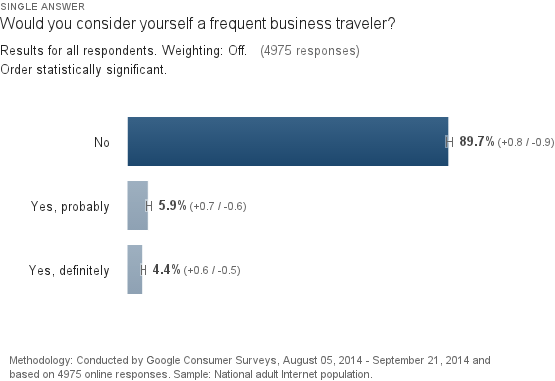
» Breakdown by sex, Chart 2 below : As to where the potential for growth lies more, women say they are less frequent business travelers, and hence more absolute numbers to grow here.
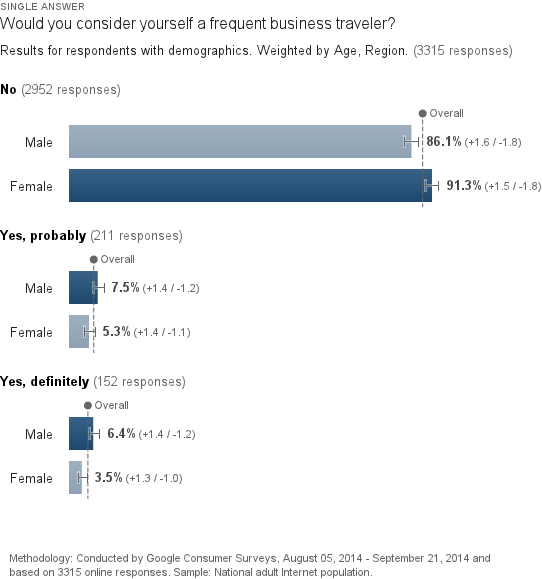
» Breakdown by age, Chart 3 below : The young Americans are more frequent business travelers, still climbing up the corporate ladder with life on the road.
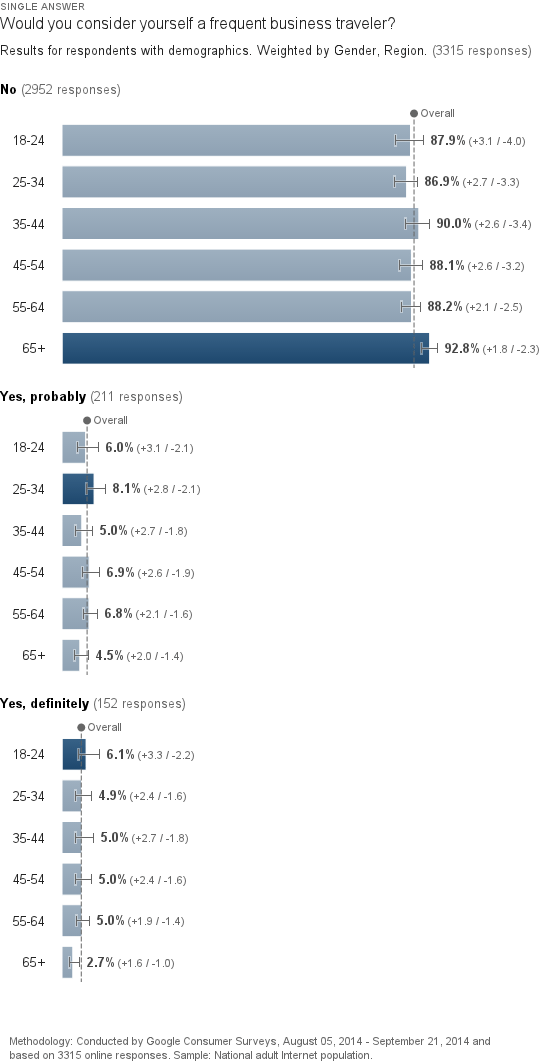
» Breakdown by region, Chart 4 below : Rural Americans are the least frequent business travelers, while Urban Americans travel more for business.
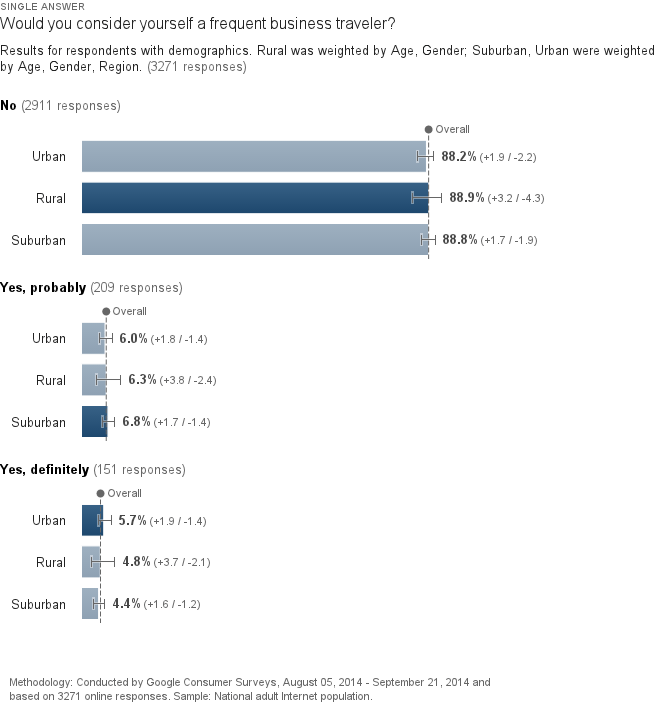
» Breakdown by income, Chart 5 below : The middle income and richer Americans are more frequent business travelers, as it is to be expected.
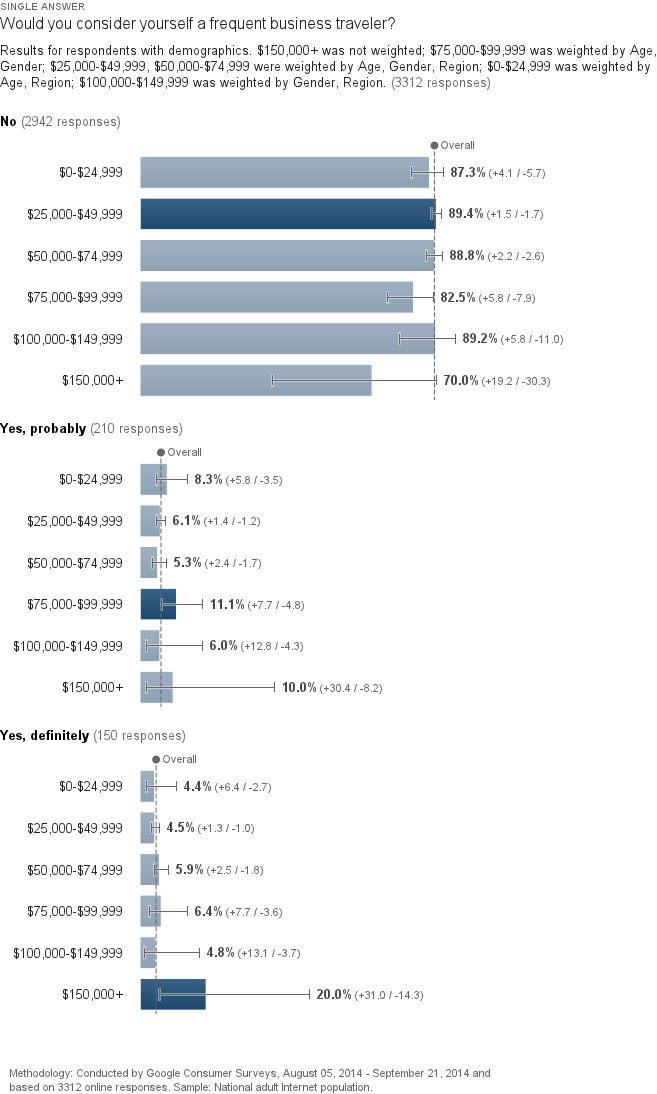
The Daily Newsletter
Our daily coverage of the global travel industry. Written by editors and analysts from across Skift’s brands.
Have a confidential tip for Skift? Get in touch
Tags: business travel , surveys , thoa
TOP DESTINATIONS FOR TRAVEL IN 2021
GET READY FOR A BACK-TO-TRAVEL MOVEMENT

As we continue emerging from a global pandemic, pent-up wanderlust has many of us looking to 2021 as a year to redeem vacation plans scrapped, or significantly altered, due to COVID-19.
Although travel won’t look quite the same in the near-term, and some popular destinations have yet to re-open to U.S. travelers, wannabe tourists are already finding great incentives to book that much-desired vacation. Hooks include jaw-dropping prices; greater booking flexibility; penalty-free change policies; and proactive health and safety protocols enforced by hotels, airlines, cruises, and tours to put COVID-conscious travelers at ease.
So, where might pent-up wanderlust take YOU in 2021? We consulted travel experts across the country—from travel agents to vacation retailers to travel publishers—to learn where they are guiding would-be travelers. We also reviewed preliminary booking trends and search data. Below are 10 destinations to whet your travel appetite.
Note: All travel is subject to changing governmental advisories and requirements, so check federal, state, and local advisories before scheduling trips.

Travel advisories for Mexico: click here .
U.S. State Department advisory: click here .
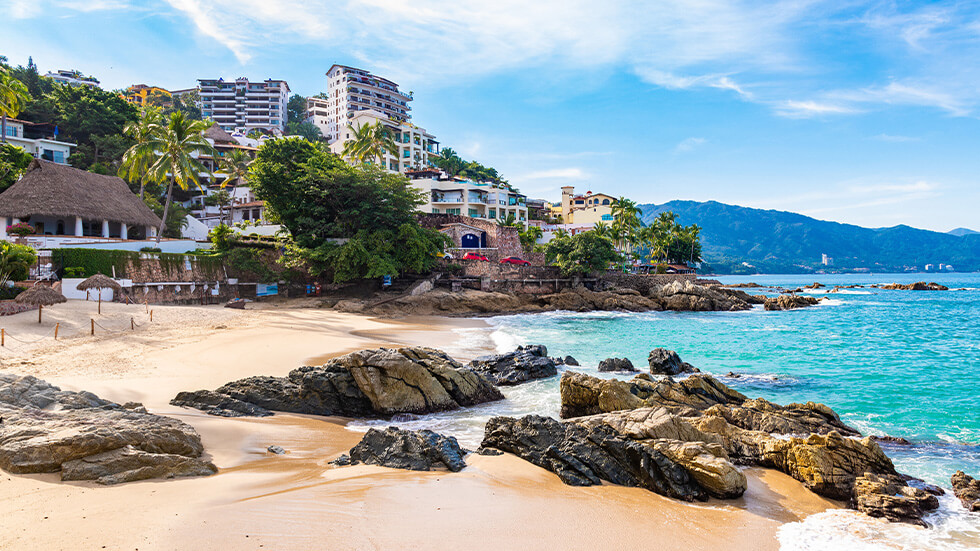
Caribbean travel advisories: click here .
U.S. Department of State advisory : click here .

Travel advisories for Tahiti: click here .
U.S. State Department advisory: click here .

Travel advisories for Italy: click here .
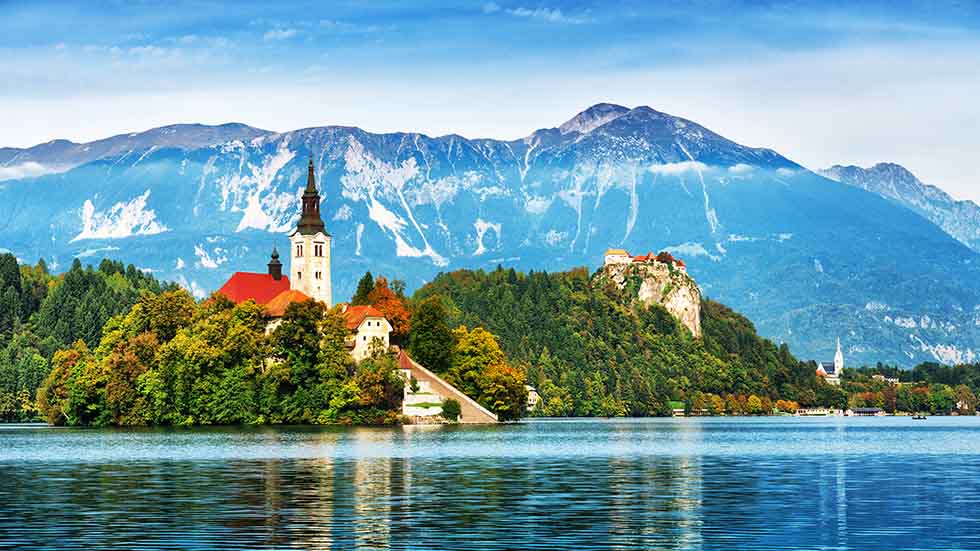
Travel advisories for Slovenia: click here .
U.S. State Department advisory: click here .

Travel advisories for Japan: click here .

Travel advisories for Alaska: click here .

More From Forbes
These are the best cities to visit alone for solo travel, according to experts.
- Share to Facebook
- Share to Twitter
- Share to Linkedin
Kayak users ranked Berlin as the best spot for international solo travel
Ready for some me time? Solo travel is the way to go. According to recent data, 50% of Americans plan to travel alone this year, and 52% will dine as a party of one. New data from a collaborative KAYAK and OpenTable survey shows a strong appetite for solo experiences, with 81% of Americans reporting having dined solo at a restaurant and 70% having traveled solo. And with September notable as a solo travel month, the travel and dining brands have teamed up to launch a solo travel guide and corresponding solo dining spot list for lone travelers domestically and abroad in each solo travel hotspot.
Kayak ranked the top destinations for solo travelers, with Washington, D.C. coming in as the number one destination for solo travel and dining in the U.S., followed by Boston, Chicago, Atlanta, Salt Lake City, Tampa, Philadelphia, Seattle, Los Angeles, and New York in tenth place.
New York City is the tenth best spot in America for solo travel, according to Kayak data
Internationally, Berlin, Vancouver, Montreal, Paris, and Milan are the top international destinations favored by U.S. solo travelers, followed by Dublin, Toronto, Dubai, Mexico City, and London.
“Search share for solo hotel rooms are up 38% since 2019, making solo travel one of this year’s hottest trends,4” shared Matt Clarke, the VP of NA Marketing at KAYAK. “And if you’re flying solo, chances are you’re dining solo too. With one third of Americans trusting fellow travelers and experts for their solo adventures, we tapped KAYAK travel experts and the dining pros at OpenTable for their best solo travel and dining hacks and tips.”
Russian Troops Captured One Of Ukraine’s Dutch Armored Vehicles, Rode It Back Into Battle—And Promptly Got Killed
Apple iphone 16 pro: new design echoed in latest leak, the sound of failure at sonos.
Of course, solo travelers need to eat, and OpenTable’s data-driven list features 75 restaurants across America, so travelers in the most popular solo travel cities can successfully seek out a table for one.
Half of Americans plan to travel alone this year
The extensive list includes Bistro Du Jour in Washington, D.C., Little Whale in Boston, Tre Dita in Chicago, Ecco Buckhead in Atlanta and Current Fish & Oyster in Salt Lake City.
Internationally, the list highlights 50 restaurants for solo diners, including Funky Fisch in Berlin, Tableau Bar Bistro in Vancouver, Brasserie 701 in Montreal, Tracé in Paris and Ristorante Torre in Milan.
“Solo dining is one of the standout trends of 2024, up 8% from last year,” said Robin Chiang, SVP of Growth for OpenTable. “Our data also shows solo diners tend to be big spenders, splurging 48% more per person compared to the average diner.”
Solo travel can be rewarding in cities and in nature
Treating yourself may be an easy decision, but deciding where to go, especially without fellow travelers to bounce ideas off of, may be a bit perplexing. To help, travelers and locals (solo dining isn’t just for those away from home), OpenTable also launched Icons , a destination featuring the best of the best restaurants in select cities, to help locals and travelers score a hot table by showing the soonest a table at a hotspot is available.
In New York, the inaugural class of icons includes Babbo Ristorante, Demo, Scarr’s Pizza, Wildair, Casa Mono, ASKA, Craft, Sushi Ichimura, l'abeille, Hav & Mar, Tempura Matsui, The Musket Room, Raf’s, Koloman, Aquavit, Le B., Le Jardinier, Caviar Russe, Café Mars, odo, Kochi, Win Son, and Mari.
“Between Icons and our solo dining and travel guide – which features restaurants for solo travelers, by solo travelers – we have dining covered for your next trip,” Chiang added.
- Editorial Standards
- Reprints & Permissions
Join The Conversation
One Community. Many Voices. Create a free account to share your thoughts.
Forbes Community Guidelines
Our community is about connecting people through open and thoughtful conversations. We want our readers to share their views and exchange ideas and facts in a safe space.
In order to do so, please follow the posting rules in our site's Terms of Service. We've summarized some of those key rules below. Simply put, keep it civil.
Your post will be rejected if we notice that it seems to contain:
- False or intentionally out-of-context or misleading information
- Insults, profanity, incoherent, obscene or inflammatory language or threats of any kind
- Attacks on the identity of other commenters or the article's author
- Content that otherwise violates our site's terms.
User accounts will be blocked if we notice or believe that users are engaged in:
- Continuous attempts to re-post comments that have been previously moderated/rejected
- Racist, sexist, homophobic or other discriminatory comments
- Attempts or tactics that put the site security at risk
- Actions that otherwise violate our site's terms.
So, how can you be a power user?
- Stay on topic and share your insights
- Feel free to be clear and thoughtful to get your point across
- ‘Like’ or ‘Dislike’ to show your point of view.
- Protect your community.
- Use the report tool to alert us when someone breaks the rules.
Thanks for reading our community guidelines. Please read the full list of posting rules found in our site's Terms of Service.

Utah's most popular Airbnbs for staycations
Local travel is booming, new Airbnb data reveals.
The big picture: More travelers are opting to stay closer to home, with Airbnb reporting a surge in bookings within a 300-mile radius — roughly a tank of gas — from where people live.
- "Local travel is growing twice as fast as long-distance travel on Airbnb," a statement from the home rental company reads.
Zoom in: Utah is among the top 10 states with the highest percentage of in-state travel, according to Airbnb's study.
- About 30% of Utahns who booked trips on the platform used it to stay in-state in the first half of 2024.
- Salt Lake residents stayed at Airbnbs in Washington County, Park City and Garden City more than anywhere else, the study found.
Zoom out: Here are the three most popular Airbnb listings among SLC-based travelers, according to the platform:
- This 4-bedroom apartment with an upstairs patio overlooking the desert in St. George
- A desert guesthouse in Ivins
- A modern, suburban home in Vineyard
Get the rundown of the biggest stories of the day with Axios Daily Essentials.

Here's how much long-term renters spend on average, and most affordable states for renters

FILE - An apartment building in Los Angeles, California, is pictured on April 24, 2024. (Myung J. Chun / Los Angeles Times via Getty Images)
With U.S. home prices and mortgage rates still high , many Americans remain renters – often spending a large percentage of their income on housing.
Younger adults between the age of 22 and 35 spend an average of $25,620 per year as a renter, according to new research.
The findings , published by credit-building platform Self Financial, come from an analysis of the average cost of rental prices, utilities, insurance, furniture, and the cost of moving over an adult renting life in all 50 U.S. states. It also factored in the cost of student accommodation over four years of college.
Home prices are finally starting to fall
In a good sign for homebuyers, the share of available listings that saw a price cut jumped to 18.9% in July – up 3.4% from the same time last year, and the highest level in two years, according to a new report published by Realtor.com. Price cuts are atypical in July, which is usually a peak time for home sales. But this year is different, because sellers are trying to lure back lukewarm buyers who are facing both high costs and steep interest rates.
Lifetime cost of rent for average American
The average American can expect to pay $333,065 for long-term renting, according to the research. This includes bills and additional rent-related expenses.
The findings are based on the assumption that the average U.S. resident will first enter the rental market at age 22 when they finish college and exit around the age of 35, which is considered the average age someone purchases their first home based on figures from the National Association of Realtors.
The findings also factored in the cost of rent for each of those years, including a 3.84% yearly increase, according to Self Financial, citing the average annual rise in rent from 2000 to 2024 based on figures from the U.S. Department of Housing and Urban Development.
Based on an average of $333,065 overall across 13 years of being a renter, that includes spending $241,303 on 13 years' worth of rent payments, and an estimated $68,074 on utilities, and $12,145 on moves within the same U.S. state, according to Self Financial’s findings.
The most expensive US states for long-term renting
When talking about renting long-term, some states stand out more than others on costs. Hawaii was found to have the highest lifetime rental costs in the study at an estimated $599,242 over a 13-year period, amounting to $46,096 per year, according to Self Financial.
Rents in Colorado pay the second-most overall at $540,772 for 13 years of rent, including expenses, and spend around $41,598 annually in the rental market.
Washington, D.C., Maine, and California rounded out the top five most expensive U.S. states for long-term renting.
"The Golden State, according to Zillow, also has six of the 10 costliest urban rental markets in the U.S.; with San Jose, San Diego, and San Francisco all priced at $3,000 or more per month on average to rent as of June 2023," Self Financial noted in its report.
Top 10 most expensive states for renters (13-year cost of rental + related costs)
- Hawaii - $599,242
- Colorado - $540,772
- District of Columbia - $479,998
- Maine - $451,217
- California - $448,852
- Connecticut - $423,348
- Rhode Island - $405,749
- Florida - $404,904
- Virginia - $403,480
- Utah - $378,722
Most affordable US states for long-term renting
Meanwhile, Kansas stands out as the cheapest U.S. state for rent, according to Self Financial’s report. A 13-year period in the rental market, including expenses, will set tenants back an average of $238,225, or $18,325 per year.
Wisconsin was found to be the second-cheapest state for long-term renters, paying an average of $240,913 over 13 years, and also with some of the lowest insurance premiums in the U.S. The research found that renters will pay just $1,924 for rental insurance over their lifetime, which is 50% lower than the national average.
Top 10 most affordable states for renters (13-year cost of rental + related costs)
- Kansas - $238,225
- Wisconsin - $240,913
- Idaho - $244,551
- Nevada - $244,782
- Mississippi - $249,329
- Oklahoma - $255,846
- Arizona - $259,413
- Indiana - $262,276
- Iowa - $264,940
- South Dakota - $265,281

IMAGES
COMMENTS
Note that this is also a rough estimate, many companies write 5% or 10% travel in every position, to avoid hiring people that are never willing to travel. It could well end up less than the 10%, or optionally more. The way I always calculate travel is doing x% of 260 work days (without holidays or PTO), so 10% would be 26 days.
10% travel — It means one or two months' worth of business trips each year. In my experience, it is relatively easy to endure as it means a few travel days (or sometimes weeks) here and there. 25% travel — You will spend at least a quarter of your working hours away from your usual place of work. It amounts to 3 months per year, one week ...
charminggeek. •. Typically it's per year. 10% travel means that about 5 weeks out of the year you can expect to be away from home. Whether that means 1 day every two weeks or one month-long trip a year is something you'll have to clarify with the potential employer. Reply reply. pdclkdc. •. I always assumed it meant per week since that's ...
It's important to note that the percentage given is an approximation and can fluctuate from time to time, based on the needs and requirements of the organization. A 10% travel commitment could involve a variety of travel-related activities. It might include attending conferences, seminars, or trade shows, meeting clients or business partners ...
If they ask an open-ended interview question like this about your willingness to travel, you should state your answer as a percentage. For example, you could say: "I'm willing to travel up to 30% of the time. That's what I did in my last job, and I know I'm comfortable with that amount.". They may ask you directly for a percentage ...
This means that you will work 1,920 hours per year. Travel percentage is a percentage of the total number of hours or days you are willing to spend traveling. For instance, if your employer requires you to be traveling at least 20% of the time, that would mean up to 384 hours of travel. Put another way, approximately 16 days per year.
Most travel jobs have a percentage of 50 percent or lower. But you can easily find positions that require more. For example, some engineering, training. and sales jobs have workers traveling 70 percent of the time! Some companies even offer positions that require 100 percent travel time.
How to Answer What Percentage Are You Willing to Travel Example. I am certainly willing to travel for work. At my last job in sales, I spent about half my time on the road, so the roughly 25% travel time we discussed for this job sounds more than acceptable. I just have a few more questions about how frequently trips are taken for this position ...
The best approach to answering this question: If you are open to travel, say so and say how much, usually noted as a percentage. Travel can sometimes be difficult to quantify as a percentage, since it usually refers to overnight travel, with each 20% indicating one night of travel per week. So travel done during the day, but returning that ...
Occasional travel. The job may require travel from time- to-time, but not on a regular basis. The travel may be for training or other work-related duties. 25% or less. The job may require up to 25% travel. 50% or less. The job may require up to 50% travel. 75% or less. The job may require up to 75% travel. 76% or greater. The job may require 76 ...
The travel percentage is usually calculated based on the total number of working hours. If you work 40 hours per week, 10% travel would equate to 4 hours spent on travel-related activities. This could include time spent journeying to client meetings, attending conferences, or visiting other company sites. ...
For jobs that have a high percentage of travel, it can also mean an impact on your weekend. For some consulting companies, 75% would mean flying to client site on Sunday, and flying back (possibly a red eye) on Thursday. ... However, my 10% travel is being gone for a couple nights a week, every week, for two three-month periods. It is SO draining!
Exactly this. I work as a developer and the role I applied for had this same 10% travel provision in the job posting. In the year I've been with this company, I only had to travel to a different state for 1 week, for a large high risk project. All expenses paid obviously. It was actually pretty fun.
File a claim for general health care travel reimbursement online. General health care travel reimbursement covers these expenses for eligible Veterans and caregivers: Regular transportation, such as by car, plane, train, bus, taxi, or light rail. Approved meals and lodging expenses. You can file a claim online through the Beneficiary Travel ...
Most travel jobs have a percentage of 50 percent or lower. But you can easily find positions that require more. For example, some engineering, training. and sales jobs have workers traveling 70 percent of the time! Some companies even offer positions that require 100 percent travel time.
In 2023, the Travel & Tourism sector contributed 9.1% to the global GDP; an increase of 23.2% from 2022 and only 4.1% below the 2019 level. In 2023, there were 27 million new jobs, representing a 9.1% increase compared to 2022, and only 1.4% below the 2019 level. Domestic visitor spending rose by 18.1% in 2023, surpassing the 2019 level.
Sounds to me like an average of 1 day travel out of every ten business days. Could be a day trip every 2 weeks, or a full week every 2-3 months. Mine has probably averaged 10% over the years, but it's not steady at all. Some years I hardly travel at all. Some years, like the current one, I travel a lot. So far I've been gone almost 5 weeks in 2016.
Seventy-five percent of travel spend is domestic. The United States is currently the world's largest domestic travel market, but China is set to overtake it in the coming years. ... 80 percent of travelers visit just 10 percent of the world's tourist destinations. Mass tourism can encumber infrastructure, frustrate locals, and even harm the ...
More than 50% of the respondents to BuzzRx's survey said having their medicine increased their stress and anxiety around a trip, and 18% said it forced them to cancel some trip activities ...
Before COVID-19, travel and tourism had become one of the most important sectors in the world economy, accounting for 10 percent of global GDP and more than 320 million jobs worldwide. In 1950, at the dawn of the jet age, just 25 million people took foreign trips. By 2019, that number had reached 1.5 billion, and the travel and tourism sector ...
Email*. The topline result: Only about 10 percent of adult Internet-using Americans consider themselves part of the frequent business travelers cohort. This is still a large 20-30 million ...
Even as the cost of living has continued to skyrocket, a substantial share of travelers are prioritizing sustainable travel features. Nearly 80 percent of travelers will pay at least 10 percent more for sustainable travel options, according to a new Euromonitor International's newly released Sustainable Travel Index 2023. That's important news at a time when the impacts of global warming are ...
Below are 10 destinations to whet your travel appetite. Note: All travel is subject to changing governmental advisories and requirements, so check federal, state, and local advisories before scheduling trips. ... or ship. In fact, a recent Booking.com survey found that 62 percent of Americans surveyed like the freedom of renting a car, with 36 ...
Kayak users ranked Berlin as the best spot for international solo travel . getty. Ready for some me time? Solo travel is the way to go. According to recent data, 50% of Americans plan to travel ...
Zoom in: Utah is among the top 10 states with the highest percentage of in-state travel, according to Airbnb's study. About 30% of Utahns who booked trips on the platform used it to stay in-state ...
Labor Day travel. Politics. Trump's plans if he returns to the White House include deportation raids, tariffs and mass firings ... Trump says he will institute a system of tariffs of perhaps 10% on most foreign goods. Penalties would increase if trade partners manipulate their currencies or engage in other unfair trading practices.
The average American can expect to pay $25,620 per year as a renter from ages 22 to 35. Hawaii renters spend an average of $599,242 on renting over a 13-year period — the most of any U.S. state ...
After two years of strong gains, demand for leisure trips is starting to dip as travelers pull back on travel spending.
CEOs of many of the biggest hotel and travel companies are coming off a bit like doomsayers these days with their warnings about the declining health of consumers and their waning appetite for ...